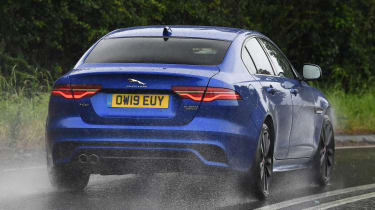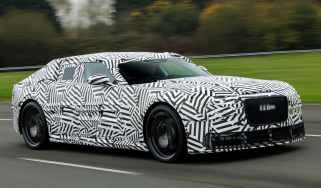Jaguar XE saloon - Engines, drive & performance
Comfortable yet sporty drive is aided by the smooth engines of the Jaguar XE
You won't be disappointed with the way the Jaguar XE drives, as it strikes a good balance between the often-conflicting priorities of comfort and driving fun. It’s not quite as sharp and driver-focused as the BMW 3 Series or Alfa Romeo Giulia, but it’s still great to drive and offers a better balance between involvement and comfort. As a result, Jaguar largely left the chassis untouched during the car’s 2019 facelift, instead streamlining the engine range.
The steering is weighty, precise and fast to react to your inputs, with a nicer feel than the BMW 3 Series. The XE feels agile too, although it's not quite as sharp as the BMW in that regard. The eight-speed automatic gearbox is particularly nice to operate, allowing you to shift gears quickly and smoothly, either by selecting 'Drive' from the new F-Type inspired gear selector (replacing the puck design), or by skipping up and down the gears using tactile metal paddles mounted behind the steering wheel.
While some fans may rue the fact there's no longer a manual gearbox, Jaguar’s automatic gearbox is smoother than many of its rivals’. However, in manual mode, it doesn’t change gear as quickly as the S tronic gearbox in the Audi A4.
All models get something called the 'JaguarDrive' system, which allows you to select Standard, Eco, Dynamic or Winter modes; each tweaking how the steering feels and how the accelerator pedal responds when you press it.
More reviews
Car trim reviews
In-depth reviews
Used car reviews
If you go for four-wheel drive, apart from the extra purchase price and higher running costs, you won't notice much of a change. The system keeps the XE rear-wheel drive most of the time, with power only being sent to the front wheels when the rear tyres begin to lose grip. You can feel it shuffling power around in very wet conditions, but other than that, it doesn't make a whole heap of difference, apart from offering extra sure-footedness in extreme weather conditions.
Jaguar XE diesel engine
Jaguar decided to withdraw all its lower-powered diesels, so the only option is the D200 version with 201bhp, which will do 0-60mph in a sprightly 6.9 seconds. If you’re considering one of the older lower-powered diesels, such as the 178bhp D180, our tests revealed it to be both smooth and responsive during acceleration, with a 0-62mph time of 7.9 seconds. Adding four-wheel drive (AWD) will add three tenths of a second to this time, however, thanks to the extra weight of the system. There’s no AWD option with the current D200.
Petrol engines
There are two versions of the same 2.0-litre petrol – the P250 produces 247bhp and the P300 has a power figure of 297bhp. The 247bhp version has rear-wheel drive and the 297bhp XE is four-wheel drive. The former has a 0-60mph time of 6.4 seconds while the latter takes 5.6 seconds. It's not a particularly tuneful engine, but you can't complain about the punch on offer - it suffers barely any lag as you press the accelerator, and feels very quick as the revs rise.













